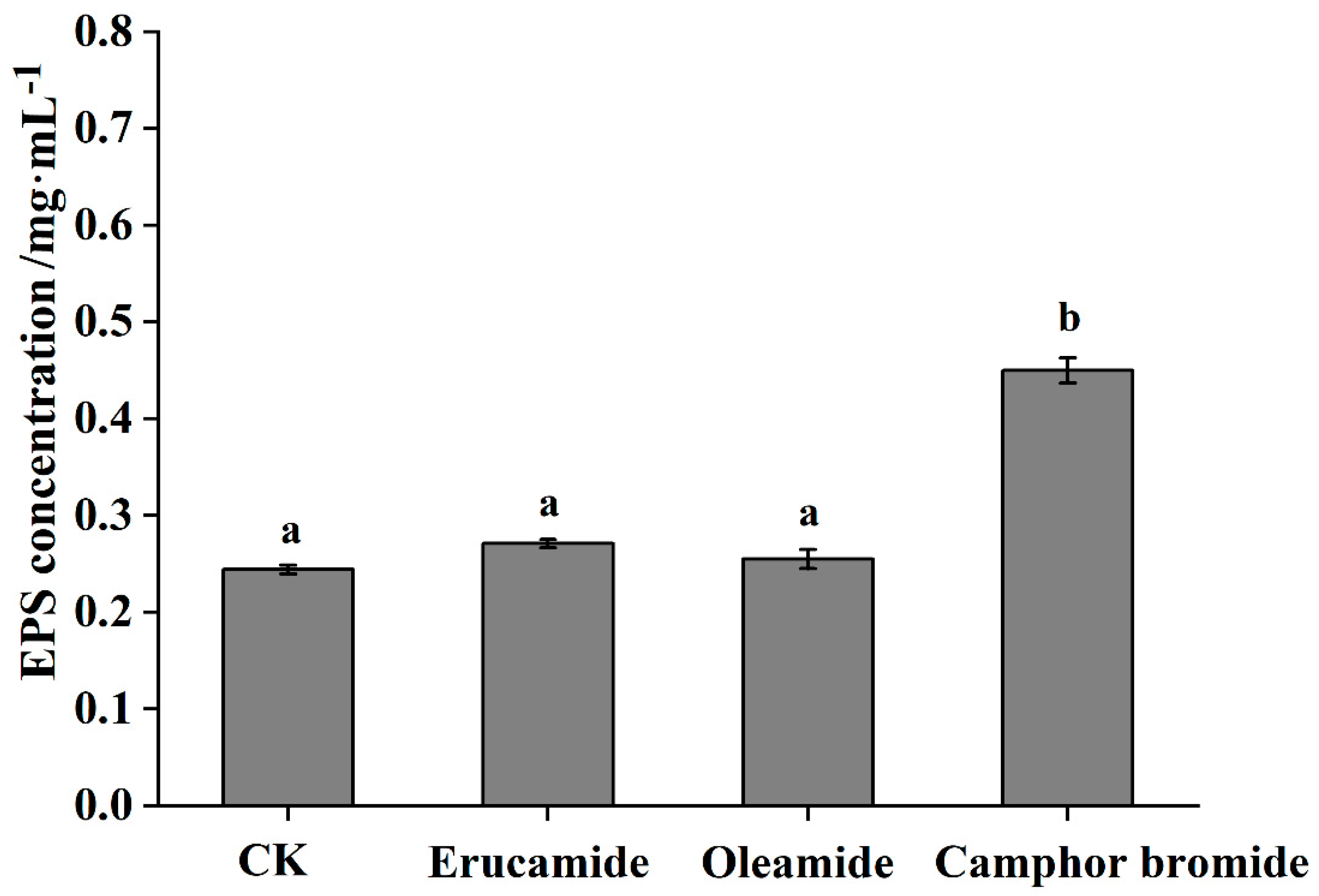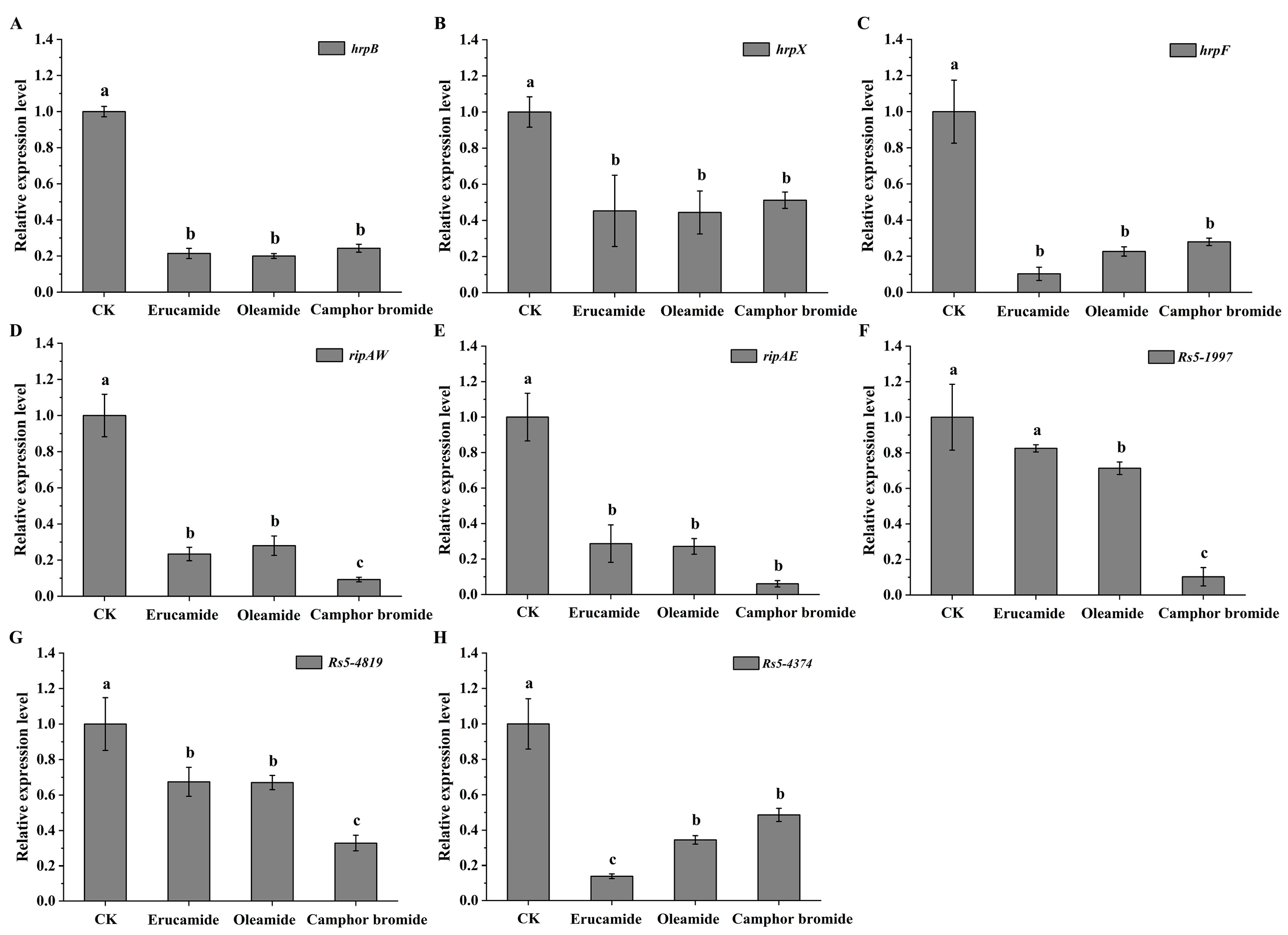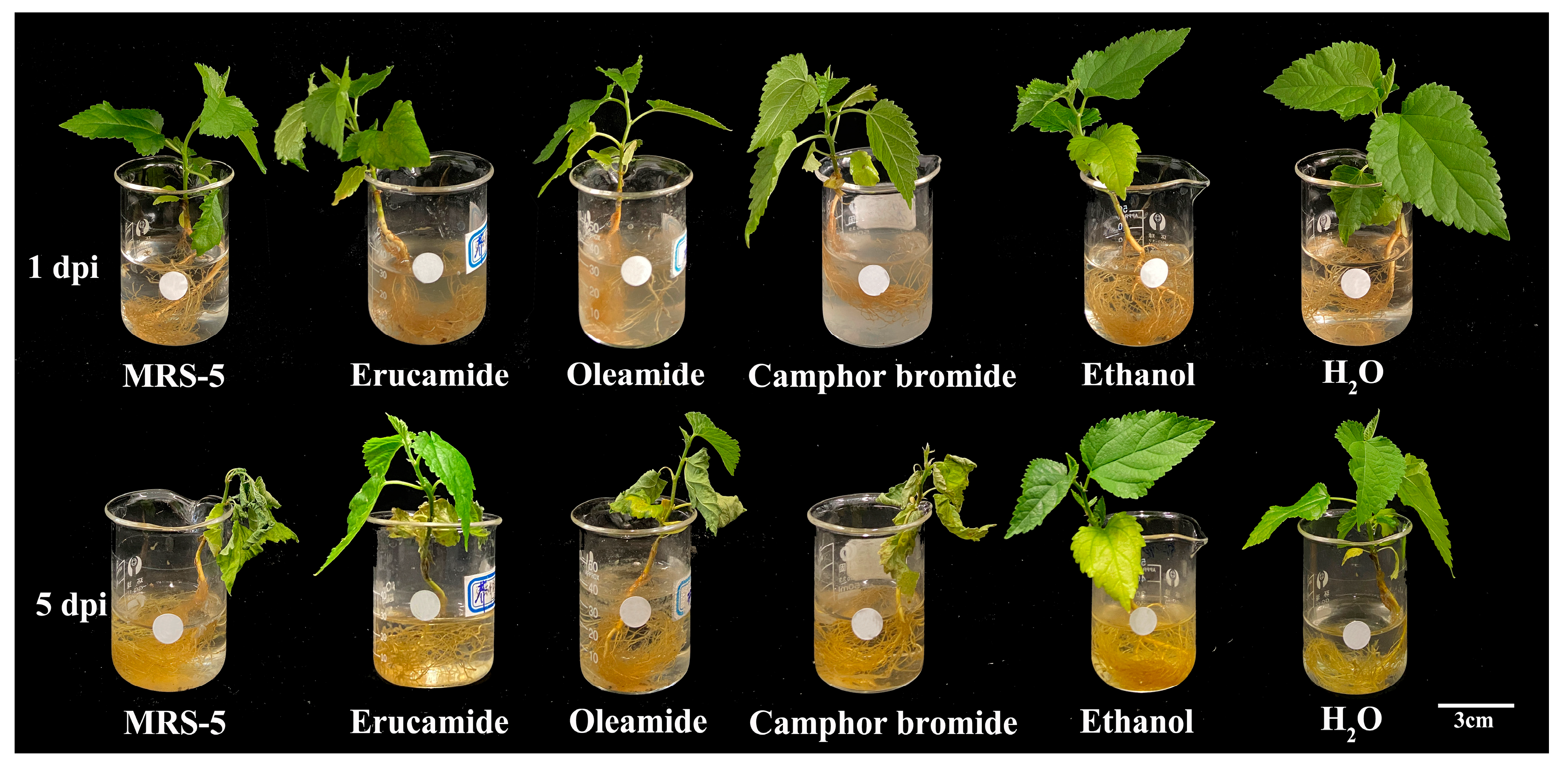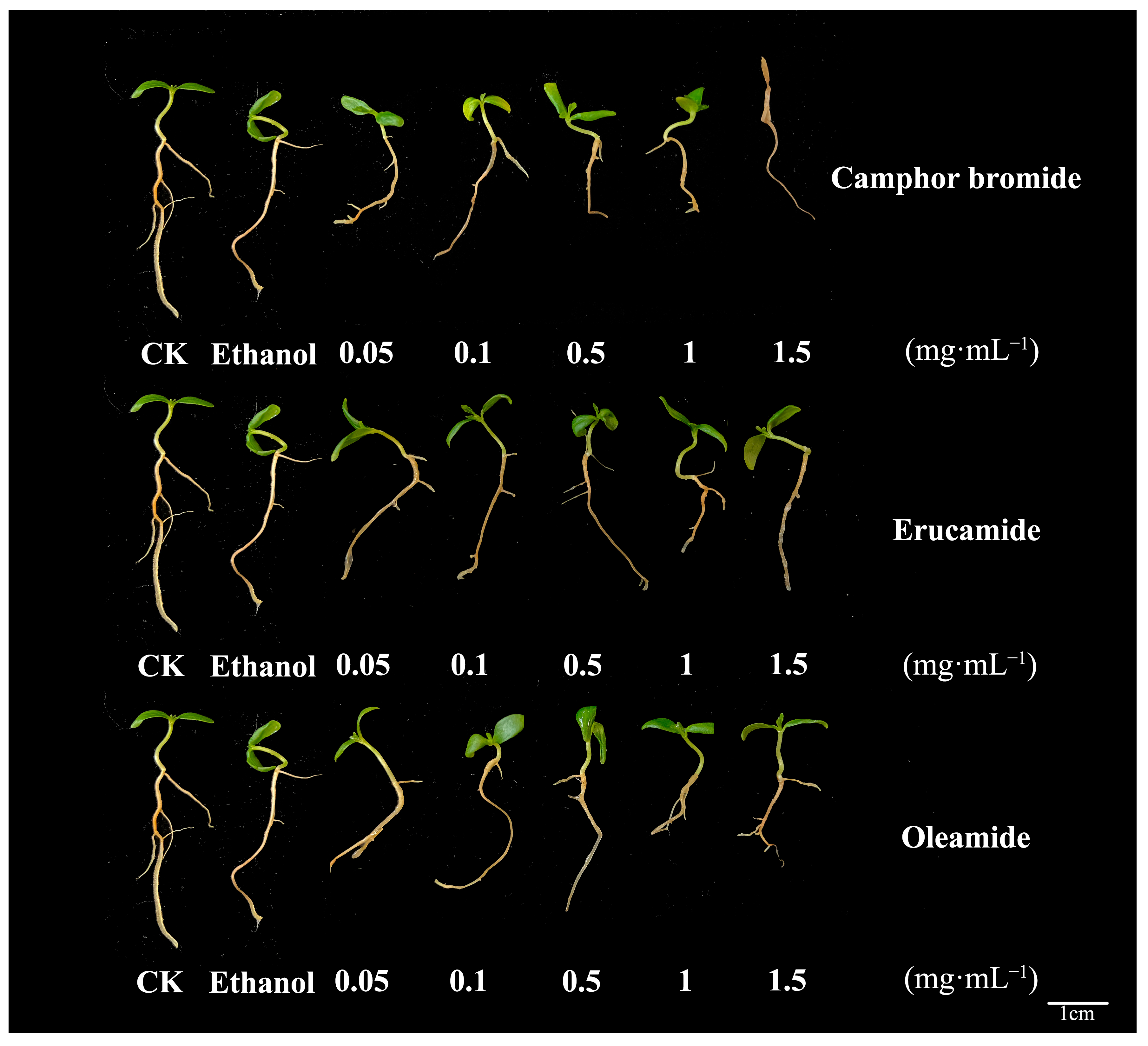Antibacterial Activity and Mechanism of Three Root Exudates from Mulberry Seedlings against Ralstonia pseudosolanacearum
Abstract
:1. Introduction
2. Results
2.1. The Effect of Active Substances in Root Exudates on the Growth of Rp
2.2. The Effect of Root Exudates on the Extracellular Polysaccharide Production of Rp
2.3. The Effect of Root Exudates on the Burst of Reactive Oxygen Species in Rp
2.4. The Effect of the Main Active Substances in Root Exudates on the Expression of Pathogenicity-Related Genes in Rp
2.5. The Effects of Active Substances in Root Exudates on the Pathogenicity of Rp and the Growth of Mulberry Seedlings
3. Discussion
4. Materials and Methods
4.1. Plant Materials and Bacterial Strains
4.2. GC/MS Analysis of Mulberry Root Exudates
4.3. Antimicrobial Activity of Mulberry Root Exudates
4.4. Scanning Electron Microscopy Analysis
4.5. Extracellular Polysaccharide Content Determination
4.6. Measurement of Reactive Oxygen Species
4.7. Gene Expression Analysis
4.8. Controlling Bacterial Wilt by Mulberry Root Exudates
4.9. Statistical Analysis
5. Conclusions
Supplementary Materials
Author Contributions
Funding
Data Availability Statement
Conflicts of Interest
References
- Lu, Q.-Y.; Ma, Y.; Smith, W.K.; Yu, J.; Cheng, Y.-Y.; Zhang, P.; Han, T.-T. The Identification of Tautoneura mori as the Vector of Mulberry Crinkle Leaf Virus and the Infectivity of Infectious Clones in Mulberry. Phytopathology 2022, 112, 435–440. [Google Scholar] [CrossRef]
- Jiao, F.; Luo, R.; Dai, X.; Liu, H.; Yu, G.; Han, S.; Lu, X.; Su, C.; Chen, Q.; Song, Q.; et al. Chromosome-Level Reference Genome and Population Genomic Analysis Provide Insights into the Evolution and Improvement of Domesticated Mulberry (Morus alba). Mol. Plant 2020, 13, 1001–1012. [Google Scholar] [CrossRef] [PubMed]
- Yuan, T.; Qazi, I.H.; Li, J.; Yang, P.; Yang, H.; Zhang, X.; Liu, W.; Liu, J. Analysis of changes in bacterial diversity in healthy and bacterial wilt mulberry samples using metagenomic sequencing and culture-dependent approaches. Front. Plant Sci. 2023, 14, 1206691. [Google Scholar] [CrossRef]
- Li, P.; Yang, Z.; Tang, B.; Zhang, Q.; Chen, Z.; Zhang, J.; Wei, J.; Sun, L.; Yan, J. Identification of Xanthones from the Mangosteen Pericarp that Inhibit the Growth of Ralstonia solanacearum. ACS Omega 2019, 5, 334–343. [Google Scholar] [CrossRef] [PubMed]
- Dai, F.; Wang, Z.; Luo, G.; Tang, C. Transcriptional analysis of different mulberry cultivars in response to Ralstonia solanacearum. Can. J. For. Res. 2016, 46, 152–162. [Google Scholar] [CrossRef]
- Chai, Y.N.; Schachtman, D.P. Root exudates impact plant performance under abiotic stress. Trends Plant Sci. 2022, 27, 80–91. [Google Scholar] [CrossRef] [PubMed]
- Badri, D.V.; Quintana, N.; El Kassis, E.G.; Kim, H.K.; Choi, Y.H.; Sugiyama, A.; Verpoorte, R.; Martinoia, E.; Manter, D.K.; Vivanco, J.M. An ABC Transporter Mutation Alters Root Exudation of Phytochemicals That Provoke an Overhaul of Natural Soil Microbiota. Plant Physiol. 2009, 151, 2006–2017. [Google Scholar] [CrossRef]
- Vives-peris, V.; de Ollas, C.; Gómez-Cadens, A.; Pérez-Clemente, R.M. Root exudates: From plant to rhizosphere and beyond. Plant Cell Rep. 2020, 39, 3–17. [Google Scholar] [CrossRef]
- Fan, H.; He, P.; Xu, S.; Li, S.; Wang, Y.; Zhang, W.; Li, X.; Shang, H.; Zeng, L.; Zheng, S.-J. Banana disease-suppressive soil drives Bacillus assembled to defense Fusarium wilt of banana. Front. Microbiol. 2023, 14, 1211301. [Google Scholar] [CrossRef]
- Li, S.; Pi, J.; Zhu, H.; Yang, L.; Zhang, X.; Ding, W. Caffeic acid in tobacco root exudate defends tobacco plants from infection by Ralstonia solanacearum. Front. Plant Sci. 2021, 12, 690586. [Google Scholar] [CrossRef]
- Teaster, N.D.; Motes, C.M.; Tang, Y.; Wiant, W.C.; Cotter, M.Q.; Wang, Y.-S.; Kilaru, A.; Venables, B.J.; Hasenstein, K.H.; Gonzalez, G.; et al. N-Acylethanolamine metabolism interacts with abscisic acid signaling in Arabidopsis thaliana seedlings. Plant Cell 2007, 19, 2454–2469. [Google Scholar] [CrossRef]
- Kim, S.-C.; Chapman, K.D.; Blancaflor, E.B. Fatty acid amide lipid mediators in plants. Plant Sci. 2010, 178, 411–419. [Google Scholar] [CrossRef]
- Sun, L.; Lu, Y.; Kronzucker, H.J.; Shi, W. Quantification and enzyme targets of fatty acid amides from duckweed root exudates involved in the stimulation of denitrification. J. Plant Physiol. 2016, 198, 81–88. [Google Scholar] [CrossRef] [PubMed]
- Ye, Z.Y.; Tu, Z.L. A study on the secretion of mulberry roots and rhizosphere microorganisms. Seric. Sci. 2005, 1, 18–21. [Google Scholar]
- Shi, H.C.; Liu, M.Y.; Wang, S.Y.; Deng, J.Y.; Li, P.; Wu, F.A. Identification of mulberry root exudates and effects of main active compounds on the growth of Ralstonia pseudosolanacearum. J. Plant Physiol. 2023, 1–19. [Google Scholar]
- Li, Y.; Jiang, G.; Long, H.; Liao, Y.; Wu, L.; Huang, W.; Liu, X. Contribution of trehalose to ethanol stress tolerance of Wickerhamomyces anomalus. BMC Microbiol. 2023, 23, 239. [Google Scholar] [CrossRef] [PubMed]
- Zhang, Y.; Chen, L.; Yoshimochi, T.; Kiba, A.; Hikichi, Y.; Ohnishi, K. Functional analysis of Ralstonia solanacearum PrhG regulating the hrp regulon in host plants. Microbiology 2013, 159, 1695–1704. [Google Scholar] [CrossRef] [PubMed]
- Chen, M.; Zhang, W.; Han, L.; Ru, X.; Cao, Y.; Hikichi, Y.; Ohnishi, K.; Pan, G.; Zhang, Y. A CysB regulator positively regulates cysteine synthesis, expression of type III secretion system genes, and pathogenicity in Ralstonia solanacearum. Mol. Plant Pathol. 2022, 23, 679–692. [Google Scholar] [CrossRef]
- Zhang, L.N.; Dong, L.; Liao, H.M. The survival strategies and related research progress of bacteria in response to excessive reactive oxygen species. Microbiol. Bull. 2021, 48, 1249–1259. [Google Scholar]
- Han, S.; Yang, L.; Wang, Y.; Ran, Y.; Li, S.; Ding, W. Preliminary studies on the antibacterial mechanism of a new plant-derived compound, 7-Methoxycoumarin, against Ralstonia solanacearum. Front. Microbiol. 2021, 12, 697911. [Google Scholar] [CrossRef]
- Baetz, U.; Martinoia, E. Root exudates: The hidden part of plant defense. Trends Plant Sci. 2014, 19, 90–98. [Google Scholar] [CrossRef] [PubMed]
- Lowe, T.M.; Ailloud, F.; Allen, C. Hydroxycinnamic Acid Degradation, a broadly conserved trait, protects Ralstonia solanacearum from chemical plant defenses and contributes to root colonization and virulence. Mol. Plant Microbe. Interact. 2015, 28, 286–297. [Google Scholar] [CrossRef] [PubMed]
- Yang, L.; Li, S.; Qin, X.; Jiang, G.; Chen, J.; Li, B.; Yao, X.; Liang, P.; Zhang, Y.; Ding, W. Exposure to Umbelliferone reduces Ralstonia solanacearum biofilm formation, transcription of type III secretion system regulators and effectors and virulence on tobacco. Front. Microbiol. 2017, 8, 1234. [Google Scholar] [CrossRef] [PubMed]
- Li, S.; Yu, Y.; Chen, J.; Guo, B.; Yang, L.; Ding, W. Evaluation of the antibacterial effects and mechanism of action of protocatechualdehyde against Ralstonia solanacearum. Molecules 2016, 21, 754. [Google Scholar] [CrossRef] [PubMed]
- Li, Y.; Hutchins, W.; Wu, X.; Liang, C.; Zhang, C.; Yuan, X.; Khokhani, D.; Chen, X.; Che, Y.; Wang, Q.; et al. Derivative of plant phenolic compound inhibits the type III secretion system of Dickeya dadantii via HrpX/HrpY two-component signal transduction and Rsm systems. Mol. Plant Pathol. 2015, 16, 150–163. [Google Scholar] [CrossRef]
- Zhou, X.; Zhang, J.; Rahman, M.K.U.; Gao, D.; Wei, Z.; Wu, F.; Dini-Andreote, F. Interspecific plant interaction via root exudates structures the disease suppressiveness of rhizosphere microbiomes. Mol. Plant 2023, 16, 849–864. [Google Scholar] [CrossRef] [PubMed]
- Hayashi, K.; Senuma, W.; Kai, K.; Kiba, A.; Ohnishi, K.; Hikichi, Y. Major exopolysaccharide, EPS I, is associated with the feedback loop in the quorum sensing of Ralstonia solanacearum strain OE1-1. Mol. Plant Pathol. 2019, 20, 1740–1747. [Google Scholar] [CrossRef] [PubMed]
- Zhang, L.; Qin, M.; Yin, J.; Liu, X.; Zhou, J.; Zhu, Y.; Liu, Y. Antibacterial activity and mechanism of ginger extract against Ralstonia solanacearum. J. Appl. Microbiol. 2022, 133, 2642–2654. [Google Scholar] [CrossRef]
- Zhao, Y.; Lu, N.; Li, H.; Zhang, Y.; Gao, Z.; Gong, Y. High glucose induced human umbilical vein endothelial cell injury: Involvement of protein tyrosine nitration. Mol. Cell. Biochem. 2008, 311, 19–29. [Google Scholar] [CrossRef]
- Li, P.; Zhang, L.; Mo, X.; Ji, H.; Bian, H.; Hu, Y.; Majid, T.; Long, J.; Pang, H.; Tao, Y.; et al. Rice aquaporin PIP1;3 and harpin Hpa1 of bacterial blight pathogen cooperate in a type III effector translocation. J. Exp. Bot. 2019, 70, 3057–3073. [Google Scholar] [CrossRef]
- Siri, M.I.; Sanabria, A.; Boucher, C.; Pianzzola, M.J. New type IV pili–related genes involved in early stages of Ralstonia solanacearum potato infection. Mol. Plant-Microbe Interact. 2014, 27, 712–724. [Google Scholar] [CrossRef]
- Niu, Y.; Fu, S.; Chen, G.; Wang, H.; Wang, Y.; Hu, J.; Jin, X.; Zhang, M.; Lu, M.; He, Y.; et al. Different epitopes of Ralstonia solanacearum effector RipAW are recognized by two Nicotiana species and trigger immune responses. Mol. Plant Pathol. 2022, 23, 188–203. [Google Scholar] [CrossRef] [PubMed]
- Aidan, D.S.; Krisztina, M.; Joann, K.W.; Chandra, A.M. Root Exudates and Microorganisms; Elsevier: Amsterdam, The Netherlands, 2023; pp. 343–356. [Google Scholar]
- Dang, K.; Hou, J.; Liu, H.; Peng, J.; Sun, Y.; Li, J.; Dong, Y. Root Exudates of Ginger Induced by Ralstonia solanacearum Infection Could Inhibit Bacterial Wilt. J. Agric. Food Chem. 2023, 71, 1957–1969. [Google Scholar] [CrossRef] [PubMed]
- Zhang, J.; Mao, Z.; Wang, L.; Shu, H. Bioassay and identification of root exudates of three fruit tree species. J. Integr. Plant Biol. 2007, 49, 257–261. [Google Scholar] [CrossRef]
- Wen, T.; Xie, P.; Liu, H.; Liu, T.; Zhao, M.; Yang, S.; Niu, G.; Hale, L.; Singh, B.K.; Kowalchuk, G.A.; et al. Tapping the rhizosphere metabolites for the prebiotic control of soil-borne bacterial wilt disease. Nat. Commun. 2023, 14, 4497. [Google Scholar] [CrossRef] [PubMed]
- Li, L.; Feng, X.; Tang, M.; Hao, W.; Han, Y.; Zhang, G.; Wan, S. Antibacterial activity of Lansiumamide B to tobacco bacterial wilt (Ralstonia solanacearum). Microbiol. Res. 2014, 169, 522–526. [Google Scholar] [CrossRef] [PubMed]
- Kim, J.-Y.; Park, S.-C.; Hwang, I.; Cheong, H.; Nah, J.-W.; Hahm, K.-S.; Park, Y. Protease inhibitors from plants with antimicrobial activity. Int. J. Mol. Sci. 2009, 10, 2860–2872. [Google Scholar] [CrossRef] [PubMed]
- Mesomo, M.C.; Corazza, M.L.; Ndiaye, P.M.; Santa, O.R.D.; Cardozo, L.; Scheer, A.d.P. Supercritical CO2 extracts and essential oil of ginger (Zingiber officinale R.): Chemical composition and antibacterial activity. J. Supercrit. Fluids 2013, 80, 44–49. [Google Scholar] [CrossRef]
- Yang, S.; Zheng, Y.; Guo, Y.; Cen, Z.; Dong, Y. Allelopathic effect of phenolic acids in various extracts of wheat against Fusarium wilt in faba bean. Funct. Plant Biol. 2023, 50, 1062–1072. [Google Scholar] [CrossRef]
- Yuan, G.-Q.; Li, Q.-Q.; Qin, J.; Ye, Y.-F.; Lin, W. Isolation of methyl gallate from Toxicodendron sylvestre and its effect on tomato bacterial wilt. Plant Dis. 2012, 96, 1143–1147. [Google Scholar] [CrossRef]
- Seddik, K.; Iratni, N.; Abderrahmane, B.; Daoud, H.; Lekhmici, A. Antioxidant and antibacterial activities of extracts from Artemisia herba alba Asso. leaves and some phenolic compounds. J. Med. Plants Res. 2010, 4, 1273–1280. [Google Scholar]
- Gnes, M.M.; Emilia Fornal, W.J.; Barbara, M.D.; Irena, C. Effect-directed isolation and identification of antibacterial Chelidonium majus L. alkaloids. Chromatographia 2015, 78, 707–716. [Google Scholar]
- Othman, L.; Sleiman, A.; Abdel-Massih, R.M. Antimicrobial activity of polyphenols and alkaloids in middle eastern plants. Front. Microbiol. 2019, 10, 911. [Google Scholar] [CrossRef]
- Vincent, C.; Remigi, P.; Roche, P.; Roblin, G.; Boucher, C. Exopolysaccharide-deficient mutants of Ralstonia solanacearum reveal that EPS is required for full virulence but is not essential for biofilm formation. Mol. Plant Microbe Interact. 2006, 19, 147–156. [Google Scholar]
- Wang, L.; Pan, T.; Gao, X.; An, J.; Ning, C.; Li, S.; Cai, K. Silica nanoparticles activate defense responses by reducing reactive oxygen species under Ralstonia solanacearum infection in tomato plants. NanoImpact 2022, 28, 100418. [Google Scholar] [CrossRef] [PubMed]
- Sumit, M.; Priyambada, A.; Itishree, K. Reactive oxygen species signaling in eggplant in response to Ralstonia solanacearum infection. J. Plant Pathol. 2014, 96, 525–534. [Google Scholar]
- Sun, Y.; Su, Y.; Meng, Z.; Zhang, J.; Zheng, L.; Miao, S.; Qin, D.; Ruan, Y.; Wu, Y.; Xiong, L.; et al. Biocontrol of bacterial wilt disease in tomato using Bacillus subtilis strain R31. Front. Microbiol. 2023, 14, 1281381. [Google Scholar] [CrossRef]
- Genin, S. Molecular traits controlling host range and adaptation to plants in Ralstonia solanacearum. New Phytol. 2010, 187, 920–928. [Google Scholar] [CrossRef]
- Popa, O.; Valls, M.; Genin, S.; Boucher, C. The type III effector repertoire of Ralstonia solanacearum strain GMI1000 is wider than anticipated. Environ. Microbiol. Rep. 2011, 3, 41–52. [Google Scholar]
- Mukaihara, S.; Kageyama, A.; Hayashi, T.; Shinohara, N.; Aoki, K. Identification and functional analysis of type III effector proteins PopP1 and PopP2 from Ralstonia solanacearum. Mol. Plant Microbe. Interact. 2008, 21, 270–279. [Google Scholar]
- Liu, Z.Y.; Zou, L.F.; Xue, X.B.; Cai, L.L.; Ma, W.X.; Xiong, L.; Ji, Z.Y.; Chen, G.Y. HrcT is a key component of the type III secretion system in Xanthomonas spp. and also regulates the expression of the key hrp transcriptional activator HrpX. Appl. Environ. Microbiol. 2014, 80, 3908–3919. [Google Scholar] [CrossRef] [PubMed]
- Wang, Y.; Yang, L.; Zhou, X.; Wang, Y.; Liang, Y.; Luo, B.; Dai, Y.; Wei, Z.; Li, S.; He, R.; et al. Molecular mechanism of plant elicitor daphnetin-carboxymethyl chitosan nanoparticles against Ralstonia solanacearum by activating plant system resistance. Int. J. Biol. Macromol. 2023, 241, 124580. [Google Scholar] [CrossRef] [PubMed]
- Genin, S.; Denny, T.P. Pathogenomics of the Ralstonia solanacearum species complex. Annu. Rev. Phytopathol. 2012, 50, 67–89. [Google Scholar] [CrossRef] [PubMed]
- Peyraud, R.; Denny, T.; Genin, S. Exopolysaccharide quantification for the plant pathogen Ralstonia solanacearum. Bio-Protocol 2017, 7, e2289. [Google Scholar] [CrossRef] [PubMed]
- Xu, H.; Ma, R.; Zhu, Y.; Du, M.; Zhang, H.; Jiao, Z. A systematic study of the antimicrobial mechanisms of cold atmospheric-pressure plasma for water disinfection. Sci. Total. Environ. 2020, 703, 134965. [Google Scholar] [CrossRef] [PubMed]
- Hu, Y.; Zhang, L.; Wang, X.; Sun, F.; Kong, X.; Dong, H.; Xu, H. Two virulent sRNAs identified by genomic sequencing target the type III secretion system in rice bacterial blight pathogen. BMC Plant Biol. 2018, 18, 237. [Google Scholar] [CrossRef] [PubMed]
- Yang, L.; Wu, L.; Yao, X.; Zhao, S.; Wang, J.; Li, S.; Ding, W. Hydroxycoumarins: New, effective plant-derived compounds reduce Ralstonia pseudosolanacearum populations and control tobacco bacterial wilt. Microbiol. Res. 2018, 215, 15–21. [Google Scholar] [CrossRef]







Disclaimer/Publisher’s Note: The statements, opinions and data contained in all publications are solely those of the individual author(s) and contributor(s) and not of MDPI and/or the editor(s). MDPI and/or the editor(s) disclaim responsibility for any injury to people or property resulting from any ideas, methods, instructions or products referred to in the content. |
© 2024 by the authors. Licensee MDPI, Basel, Switzerland. This article is an open access article distributed under the terms and conditions of the Creative Commons Attribution (CC BY) license (https://creativecommons.org/licenses/by/4.0/).
Share and Cite
Li, P.; Wang, S.; Liu, M.; Dai, X.; Shi, H.; Zhou, W.; Sheng, S.; Wu, F. Antibacterial Activity and Mechanism of Three Root Exudates from Mulberry Seedlings against Ralstonia pseudosolanacearum. Plants 2024, 13, 482. https://doi.org/10.3390/plants13040482
Li P, Wang S, Liu M, Dai X, Shi H, Zhou W, Sheng S, Wu F. Antibacterial Activity and Mechanism of Three Root Exudates from Mulberry Seedlings against Ralstonia pseudosolanacearum. Plants. 2024; 13(4):482. https://doi.org/10.3390/plants13040482
Chicago/Turabian StyleLi, Ping, Siyi Wang, Mengyuan Liu, Xue Dai, Huicong Shi, Weihong Zhou, Sheng Sheng, and Fuan Wu. 2024. "Antibacterial Activity and Mechanism of Three Root Exudates from Mulberry Seedlings against Ralstonia pseudosolanacearum" Plants 13, no. 4: 482. https://doi.org/10.3390/plants13040482





